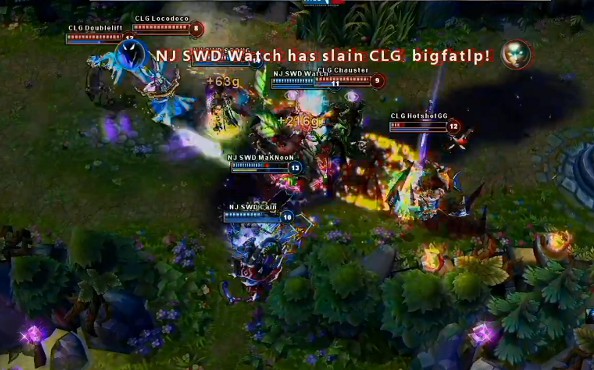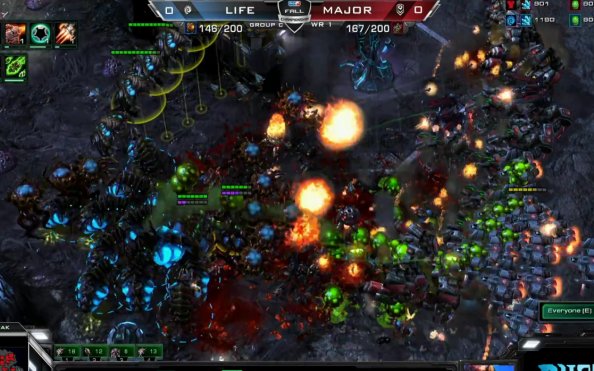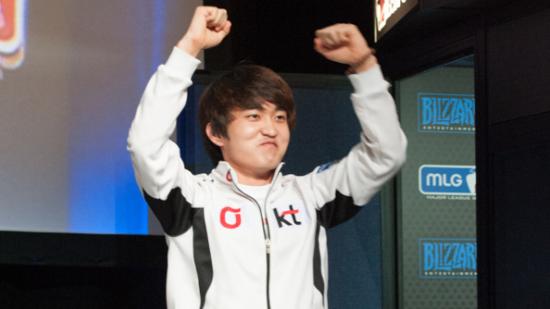The MLG’s 2012 season concluded this weekend with the Fall Championship, where Azubu Blaze took first place out of eight teams in the League of Legends tournament, and where Life fought through an actual league’s worth of StarCraft legends to win his first MLG. Freelance writer and burgeoning eSports nerd Andrew Groen and I split the StarCraft 2 and League of Legends coverage this weekend, and today we’re closing out our coverage with our thoughts on the Fall Championship and what they say about this moment in eSports.
Rob: I have to admit, I was a little jealous that you were getting to do the StarCraft coverage this weekend, because it seemed like every day there was some insane upset match, or a clash of StarCraft legends. I’d probably be enraged if the League of Legends tournament hadn’t turned out to be so outstanding.
But I find myself a bit fascinated by Life. Not only is he incredibly young and successful, but he is simply playing a different Zerg game than anyone else in StarCraft 2 right now. I didn’t see many of his games at MLG, but is he still basically thumbing his nose at the current Infestor-Brood Lord endgame?
Andrew: The SC2 play this weekend was indeed spectacular. The zany matches and epic comebacks weren’t just coming each day: it was multiple times on each of the three days. It was probably the most entertaining weekend of SC2 I’ve year seen in the last eight months.
I came away with mixed reactions about Life. He definitely wasn’t playing the same late-game style that many other Zergs are favoring right now, but that tended to be because he was playing the likes of Flash, who never gave him a chance to get to the late-game. His biggest matches of the weekend, his best of sevens against Flash and Leenock, tended to be very fast-paced with both players fighting so fiercely that there was never a chance to tech up into the late-game.
While Life was the most dominant player of the weekend, he wasn’t the most entertaining. His rock solid play is great for winning games, but I’m not convinced it’s the best for spectating. That award goes to either Flash or Leenock. Flash’s best of seven against Naniwa and his first best of three against Life were instant classics. Meanwhile, Leenock’s creativity was the story of the weekend. Every single match was a new strategy, and his series’ against Oz and Bomber were the most entertaining of the weekend.
I didn’t get a chance to tune into League of Legends. How did the weekend go on that front? You seemed a bit disappointed on the first day. Did it get off to a rough start?

Rob: It did, mainly because there was only one stream for League of Legends and it was always dominated by the big-name teams. The trouble is: while CLG Prime and Team SoloMid are certainly famous teams with a lot of historical success, their performance doesn’t always live up to their reputation. But there is this lag between perception and reality, and perception is what dictates which matches get the main stage treatment. So my League of Legends weekend began with CLG Prime getting utterly crushed by NaJin Sword. Meanwhile, Team Dynamic never got to stream a match during this tournament, even though they held their own against Azubu Blaze for a little bit there in the first round.
Obviously, the ideal solution is for the MLG to simply put up another stream for League of Legends, as they’ve done for StarCraft. It was infuriating to be reading tweets at the end of the night about this astonishing upset by Dignitas over CLG Europe (Season 2 semifinalists, for crying out loud!) while the LoL stream was already dead and the last game we’d seen was a pretty lopsided 2-1 win by SoloMid over Curse. The fact is, you just never know which games are going to be great, and with only eight teams competing, viewers should have had more options, not fewer.
Setting that aside, however, it was still a terrific weekend and, if you were skeptical about League of Legends as an eSport, there was a lot to watch and appreciate thanks to the smaller format. A lot of these teams, particularly the Americans, are having this wake-up call that they’re no longer competitive on the world stage, and they were playing as much to improve as to win. So just over the course of three days, you could see these teams adapting to the new metagame, the overall strategies that are dominant in League of Legends at the moment, and trying to improve their play. Like how Azubu Blaze came back from their defeat by NaJin Sword to completely dominate them just by tweaking their approach to top-lane and the jungle, and by being more aggressive rather than relying on heavy farming to win the game. It’s need to see a team evolve in the space of a weekend, and not something you often get to appreciate.
But that puts me in mind of another issue: stratification. I see it happening in League of Legends a little bit, and it worries me. You pretty much knew who the finalists were going to be from day one, and that made their matches kind of boring until the end. Just like you knew Curse and SoloMid were probably not going to do much of anything. I was stunned that CLG Prime managed to get their act together enough to survive to the losers’ bracket semifinal. There’s really a shockingly small number of teams that can really compete at the absolute highest, championship-winning level. Do you feel like that is an issue in StarCraft at all?
Andrew: Stratification is only really an issue in StarCraft if you care about the division between South Koreans and…well, the rest of the world. The real strength of the game is the deep talent pool. There is definitely a class of elite players, but that group is probably 25-40 players so it rarely gets stale.
It can get a little frustrating that the Western players that are more relatable to an MLG audience get beat up by the South Koreans, but I never find it to be an issue as I find it hard to root for the top Westerners anyways as they tend to be guys like Idra, NaNiwa, and Stephano who all have pretty dismal reputations.
Beyond that it can be fascinating to watch a guy like Leenock – who’s not ordinarily a top player in South Korea – do extremely well at MLG as he competed for his third title. It’s awesome to see how a format like MLG’s can tip the balance in favor of creative and flexible players and equalize otherwise lopsided matches.
It’s interesting though that you brought up grievances with the MLG production as you had trouble seeing the best action. There were several instances in SC2 in which dead air was being played while major matches seemed to be in progress.
This was just one of the many problems MLG had with their streams this weekend. Apparently, Hurricane Sandy canceled all of their flights from New York to Dallas and so the entire team had to drive themselves down to Dallas in 24 hours just to get things set up. By the last day they had recovered, but the first two were a mild disaster. It’s incredibly fortunate for them that the matches were so fantastic, or they may have lost some repeat customers for the next tournament.
Did you hear anything about how the Halo 4 tournament went? I would have loved to tune into that, but my time was monopolized by SC2. League of Legends and SC2 feel a bit like they’re plateauing in popularity for the moment after the explosion of late 2011/early 2012. Do you feel like there’s growth opportunity for MLG over the next year in revitalizing a dormant competitive Halo scene?

Rob: Well, LoL numbers are still growing. At least for the big tournaments. As for StarCraft 2, there is discussion of stagnation, as I’m sure you know, but I’m not sure I buy it. It just had a year of huge growth where a number of eSports organizers and leagues have tried to give us even more tournaments to watch. So while stream numbers might be down, there’s simply a lot more StarCraft 2 to watch. It remains to be seen whether we’re in a consolidation phase, or a stagnation.
As for Halo, I think eSports as a whole is so centered on PC that games like Halo end up in this weird place. Tons of people play Halo, and the community is passionate, but I’m just not sure you’re going to have this huge spectator culture that’s developed around League and StarCraft. Besides which, the shooter audience moves on to other games on console, don’t they? Do the consoles really have an equivalent of Counter-Strike, where you’ve got over a decade of history and competition?
Andrew: There’s definitely an issue of audience retention as the trends move from game to game, but Halo and Call of Duty both remain more or less the same as the game moves from installment to installment. You get new maps, game modes, and abilities, but the core is essentially the same. So while there are peaks and valleys in popularity between releases, the audience eventually comes back. I think if you had a dynamic shooter that was flexible enough to allow for an evolving metagame then you’d see more people sticking with the game.
Rob: We’ll see how the shooter scene develops in the next year. I still don’t see a lot of excitement around CS:GO, and Shootmania is an unproven contender. The biggest challenge shooter face is the spectator experience: it’s awful.
Andrew: First-person shooters aren’t the only games in danger of stagnating. I don’t follow the scene very closely, but I’ve heard rumblings that LoL has stagnated to a degree. That the strategies tend to be very predictable. Any truth to that?
Rob: I don’t really know the sport well enough to speak to this, honestly. I know that Riot are looking to change the jungle, but I’m not sure what those changes will look like. I suspect we’ll see a lot of new stuff next year, and Riot’s changes to the 3v3 Twisted Treeline map are really exciting. I’m not sure Riot will ever overhaul Summoner’s Rift that much, since this is a map design that pretty much defines the MOBA genre. But they try to keep the game fresh. Besides, the merging of the western and Asian competitive scenes, plus the addition of innovators like Moscow 5, have already changed the game quite a bit.
The pace of change in eSports is so rapid that I think we end up having a distorted perception of the big picture. There’s a tendency to identify momentary phenomena as enduring trends. Because for those of us who are watching tournaments every other week, three months is a lifetime. Scores of games and matches. But then you have to stop back and realize it’s only been three months. If eSports grow and change as much in 2013 as they did in 2012, or even just half of 2012, we’re in for one hell of a year.
But seriously: buff Terran and Heimerdinger, or eSports will be dead by Christmas.
